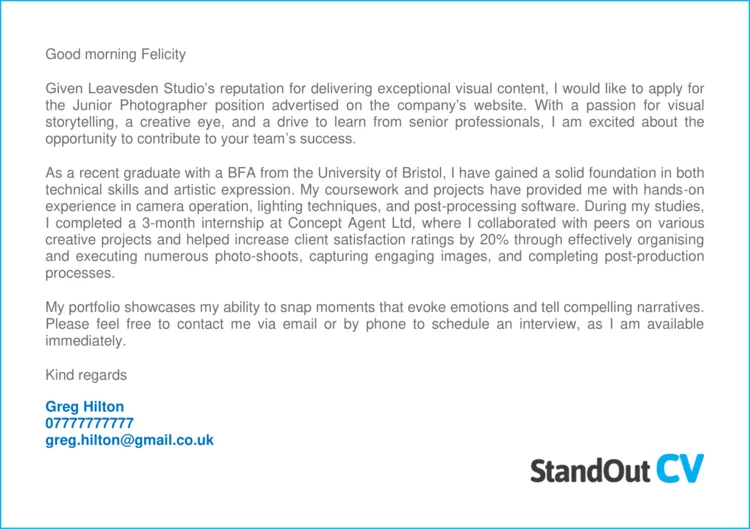Understanding the Importance of a Photographer Cover Letter
In the competitive world of photography, a compelling cover letter can be your key to unlocking opportunities. It’s often the first impression you make on potential employers or clients, and it’s your chance to showcase your personality, skills, and passion beyond your portfolio. While your photographic work speaks volumes, a well-crafted cover letter provides context, explains your unique selling points, and demonstrates your communication skills. This document is not just a formality; it’s a crucial tool for getting your foot in the door and landing the photography job or project you desire. A strong cover letter highlights what makes you stand out, proving why you’re the perfect fit.
Why a Cover Letter Matters for Photographers
For photographers, a cover letter goes beyond simply stating your interest; it’s an opportunity to tell your story. It allows you to explain the ‘why’ behind your work, the inspiration, and the creative process. This is particularly important as photography is an art form and an expression of an individual’s vision. A cover letter lets you personalize your application, connecting with the hiring manager on a deeper level. It demonstrates your ability to communicate effectively, which is essential when collaborating with clients, art directors, or other team members. It also allows you to address any potential gaps in your resume or highlight specific aspects of your experience that directly align with the job requirements. It helps you stand out from a crowd of applicants by showcasing your professionalism and commitment to the opportunity.
Showcasing Your Uniqueness
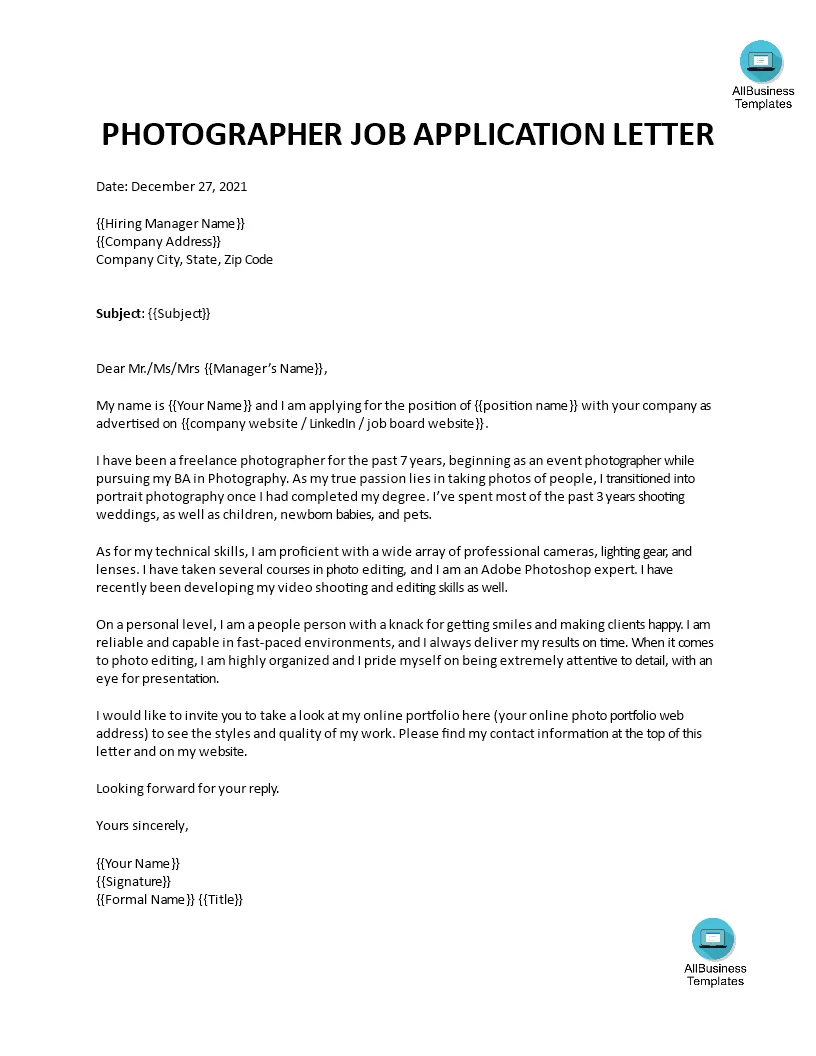
Your cover letter is the space to highlight what makes your work unique. What sets your photographic style apart from others? Is it your ability to capture candid moments, your mastery of specific techniques, or your specialization in a niche area such as weddings, portraits, or landscapes? Focus on these aspects. Mention any awards, publications, or notable clients you’ve worked with. If you have a particular philosophy or approach to your photography, share it. This can be a powerful way to connect with potential employers who value creativity and vision. Don’t be afraid to showcase your personality. Your enthusiasm and dedication to your craft should shine through in every sentence.
Key Elements of a Winning Photographer Cover Letter
Contact Information and Salutation
Start with your contact information at the top: your name, phone number, email address, and website or online portfolio link. Always address the hiring manager by name, if possible. Research the company or organization to find the appropriate contact person. Using a personalized salutation, like ‘Dear Mr./Ms. [Last Name],’ shows that you have taken the time to learn about the company and the individual you are addressing. If you cannot find a specific name, ‘Dear Hiring Manager’ is a professional alternative.
Crafting a Compelling Opening
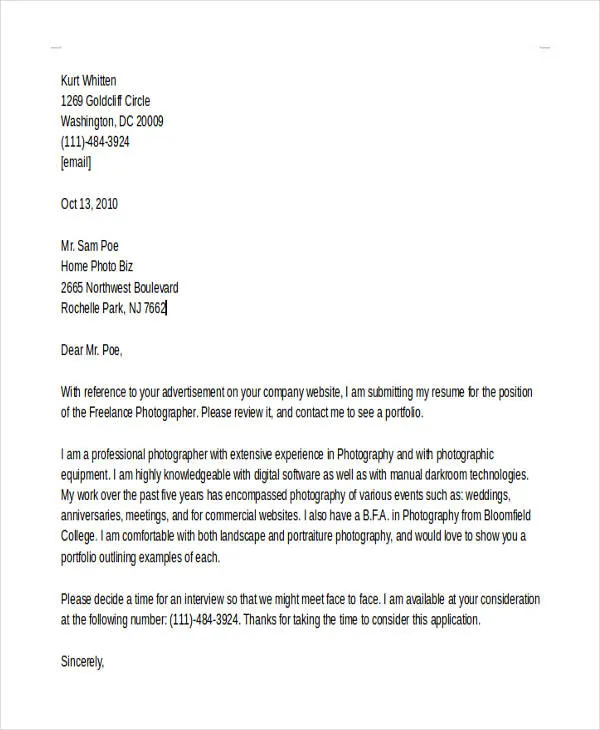
Your opening paragraph should immediately grab the reader’s attention. Clearly state the position you are applying for and where you saw the job posting. Briefly mention your passion for photography and why you are interested in the specific opportunity. Instead of a generic opening, try something more engaging, such as highlighting a particular project or skill that aligns with the company’s needs. For example, if applying to a travel photography position, you could start by referencing a recent trip or a stunning image in your portfolio that showcases your ability to capture a sense of place.
Highlighting Your Skills and Experience
This is where you showcase your relevant skills and experience. Tailor this section to match the job requirements. Identify the key skills the employer is looking for and provide specific examples of how you have demonstrated those skills. Quantify your achievements whenever possible. For example, instead of saying ‘I have experience with event photography,’ you might say, ‘I have successfully covered over 50 events, consistently delivering high-quality images on deadline.’ Mention any software proficiencies (e.g., Adobe Photoshop, Lightroom), technical skills (e.g., lighting, composition), and other relevant qualifications that showcase your capabilities. Use action verbs to describe your accomplishments; focus on what you did and the positive outcomes that resulted.
Showcasing Your Photography Style and Portfolio
Your portfolio is crucial, but the cover letter allows you to provide context. Briefly describe your photographic style and the types of projects you enjoy. Mention specific images or collections in your portfolio that best align with the job or client’s needs. Include the link to your online portfolio, and mention the quality of your work. If you have a particular niche, emphasize it here. For example, if you are applying for a portrait photography position, highlight images that showcase your ability to connect with people and capture their personalities. If you’re applying to a commercial photography role, mention specific projects that demonstrate your ability to meet client briefs and deliver professional-grade results.
Demonstrating Your Passion and Enthusiasm
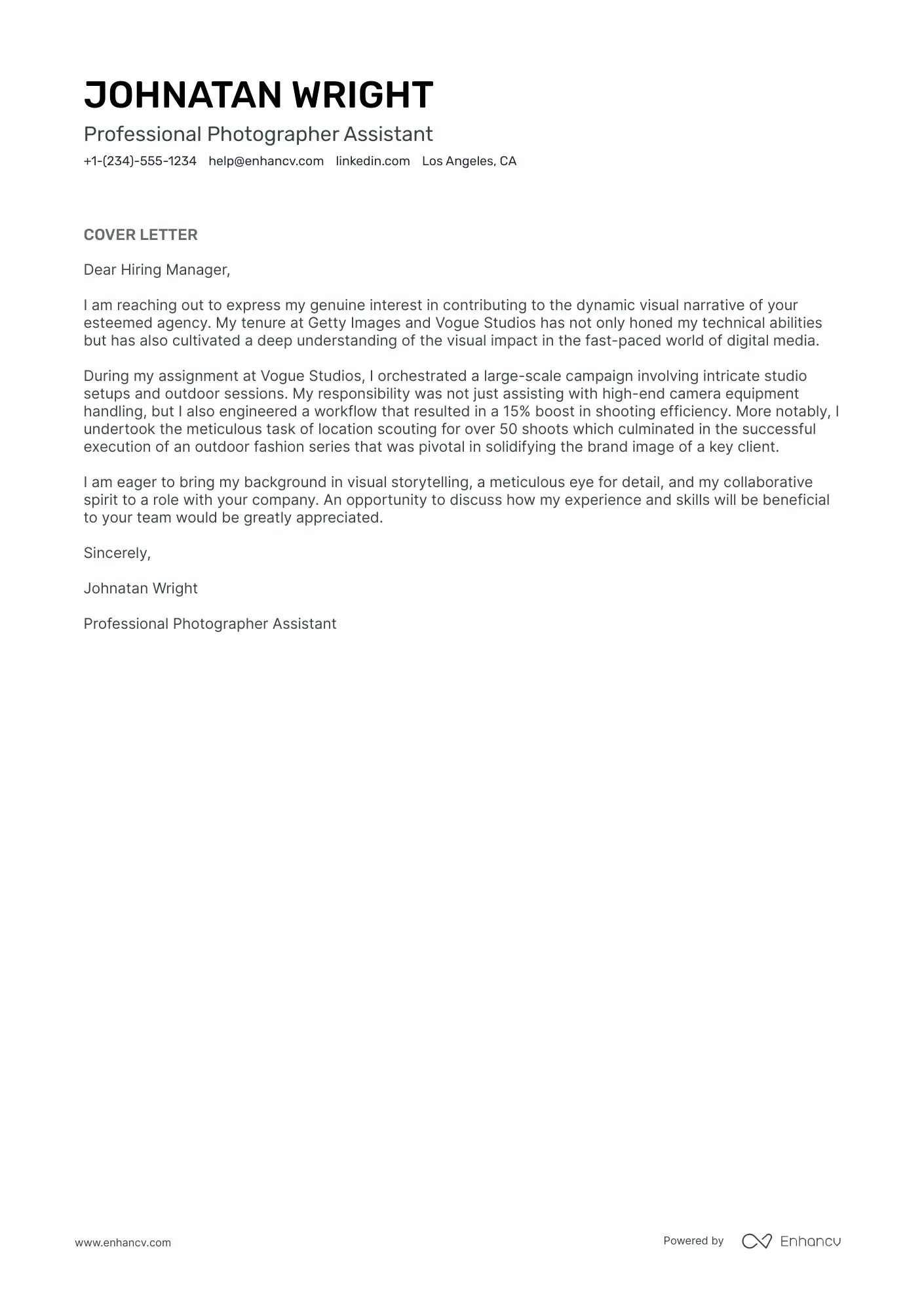
Let your enthusiasm for photography shine through. Explain why you are interested in the specific opportunity and what excites you about the company or project. Discuss what inspires your work and what you hope to achieve in your photography career. Showcase your knowledge of the company. Demonstrate that you have researched the organization and that you understand its mission and values. This demonstrates that you’re not just looking for any job, but that you are genuinely interested in working with them. If you admire the company’s work, specifically mention what aspects you find appealing, indicating you have the skills and ambition to match their standards.
Closing and Call to Action
Conclude your cover letter with a strong call to action. Reiterate your interest in the position and your excitement about the opportunity. Express your availability for an interview and thank the hiring manager for their time and consideration. If applicable, mention your willingness to provide additional materials or samples of your work. Keep it concise and professional. A well-crafted closing reinforces your message and leaves a positive impression on the reader, increasing the likelihood of a positive response.
Cover Letter Formatting and Design
Choosing the Right Font and Layout
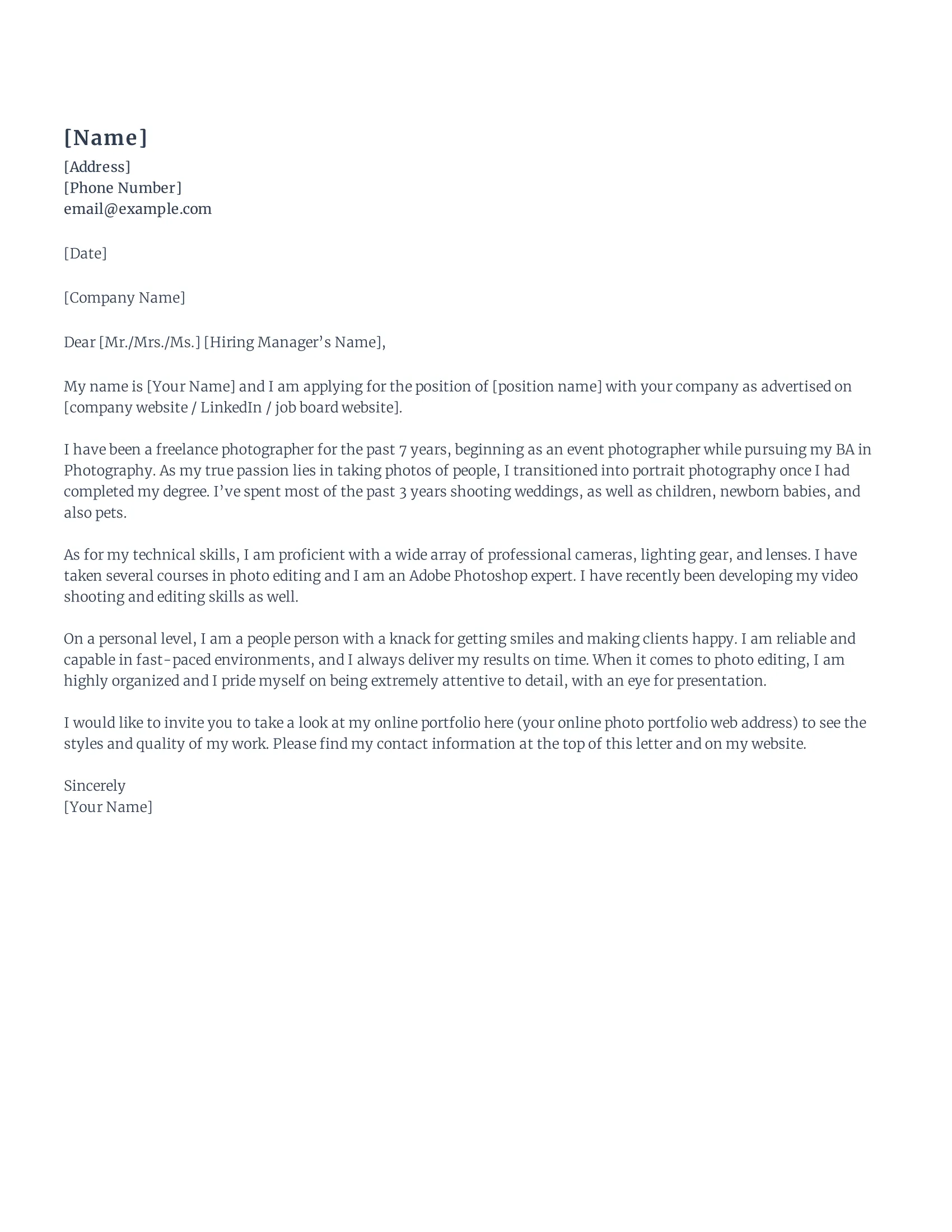
Your cover letter’s visual appearance should reflect professionalism. Choose a clean, readable font such as Arial, Times New Roman, or Calibri. Use a font size between 10 and 12 points for readability. Maintain a consistent font throughout the document. Utilize a clear layout with ample white space to make it easy for the reader to scan and digest the information. Ensure your contact details and the date are properly aligned and that each section is clearly separated. A well-formatted letter is easier on the eyes and portrays a sense of order and attention to detail.
Ensuring Readability and Professionalism
Your cover letter should be easy to read. Keep paragraphs concise and focused on one main idea. Use bullet points to highlight key skills, accomplishments, or portfolio highlights. Ensure correct grammar, spelling, and punctuation. Proofread your letter carefully before sending it, and consider having someone else review it for you. Avoid jargon or overly complex language. The goal is to communicate your qualifications clearly and concisely, making it easy for the hiring manager to understand your value. Professionalism extends to every aspect of your application; every detail reflects your work ethic.
Photographer Cover Letter Examples
Example Cover Letter for a Freelance Photographer
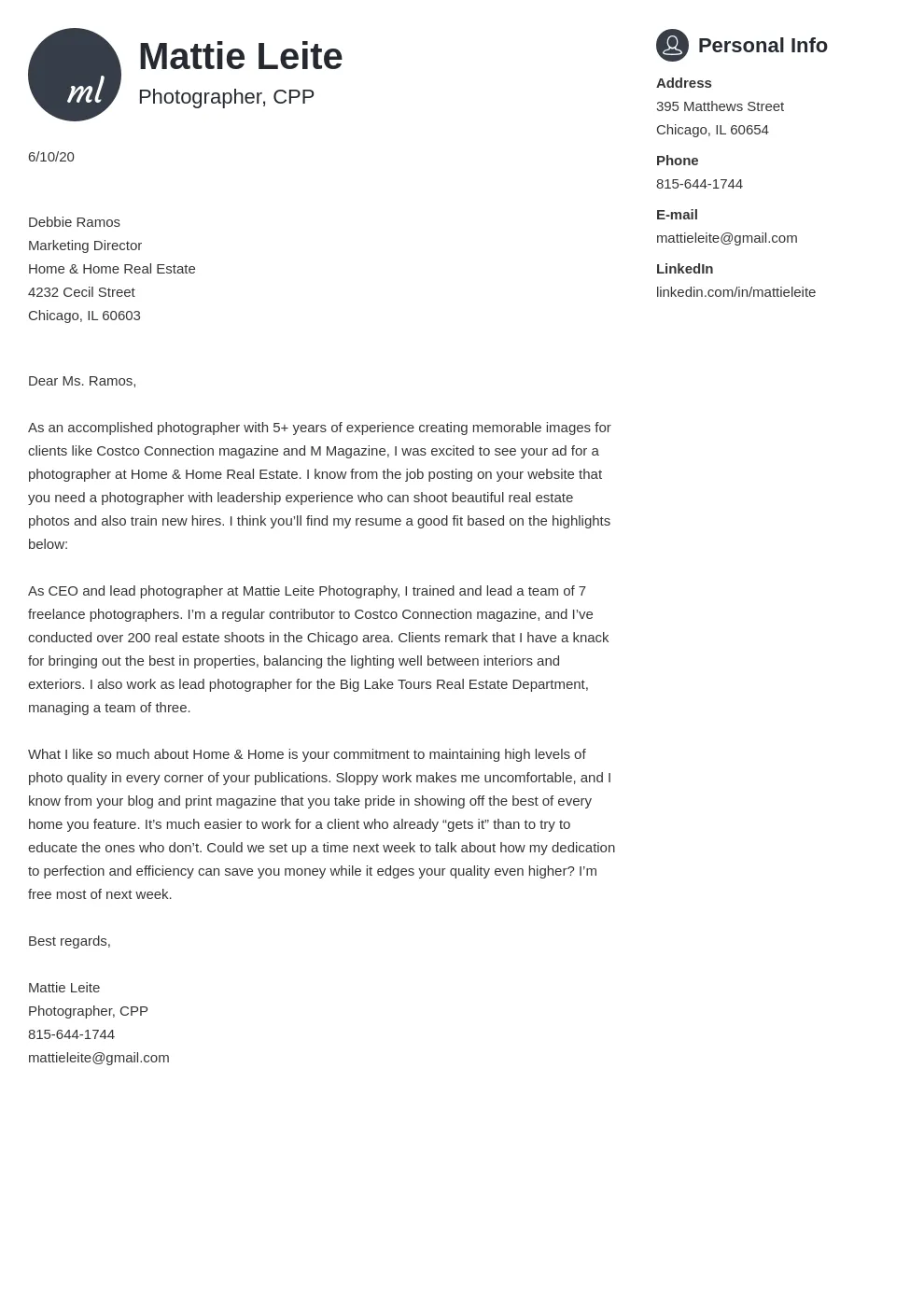
Dear [Client Name],
I am writing to express my interest in providing freelance photography services for [Project/Event]. I have been a professional photographer for [Number] years, specializing in [Specific Type of Photography]. My portfolio, available at [Portfolio Link], showcases my ability to capture [Specific Style/Technique] while consistently exceeding client expectations. I am experienced in [List relevant skills] and I am confident in my ability to deliver high-quality images that meet your specific needs. I am available on [Dates] and am eager to discuss your project further. Thank you for your time and consideration.
Sincerely, [Your Name]
Example Cover Letter for a Photography Job
Dear [Hiring Manager Name],
I am writing to apply for the [Job Title] position at [Company Name], as advertised on [Platform]. With [Number] years of experience and a passion for [Photography Genre], I believe my skills and experience align well with your requirements. My portfolio, showcasing my ability to create [Specific Style/Technique], can be viewed at [Portfolio Link]. I have extensive experience in [List skills], and I am excited about the opportunity to contribute to [Company Name]’s success. Thank you for your time; I am eager to discuss the position further.
Sincerely, [Your Name]
Example Cover Letter for a Photography Internship
Dear [Hiring Manager Name],
I am writing to express my interest in the Photography Internship position at [Company Name]. As a passionate photography student at [School Name], I am eager to gain hands-on experience in a professional environment. My portfolio, which demonstrates my proficiency in [Specific Skills/Techniques] can be found at [Portfolio Link]. I am a quick learner and committed to contributing to your team. I am available to start on [Date] and look forward to the possibility of joining your team.
Sincerely, [Your Name]
Tips for Tailoring Your Cover Letter
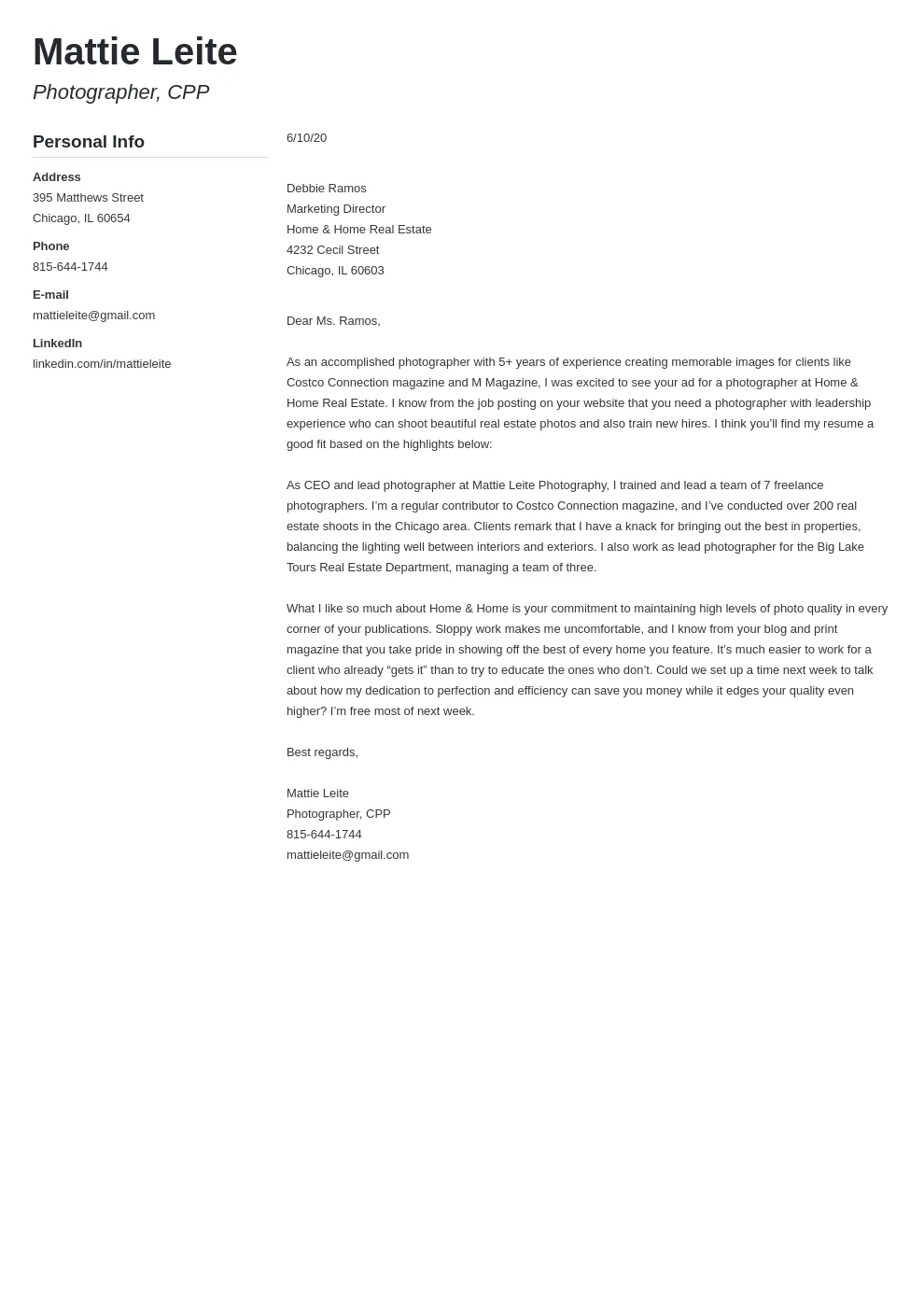
Researching the Company and Job Requirements
Before you start writing, research the company and the specific job requirements. Understand the company’s mission, values, and the types of photography they specialize in. Analyze the job description carefully and identify the key skills, experiences, and qualifications they are seeking. This knowledge will help you tailor your cover letter to address their specific needs and show that you have a genuine interest in the opportunity. Tailor your letter by ensuring your skills match their needs, and by addressing the company’s mission and values to showcase your understanding of the company’s objectives.
Customizing Your Letter for Each Application
Avoid using a generic cover letter for every application. Customize each cover letter to align with the specific requirements of the job and the company’s values. Highlight the skills and experiences that are most relevant to the position. Reference specific projects or images in your portfolio that align with their needs. Demonstrate your knowledge of the company and your understanding of the role. Personalized cover letters are more likely to capture the hiring manager’s attention and demonstrate your genuine interest in the opportunity.
Proofreading and Editing
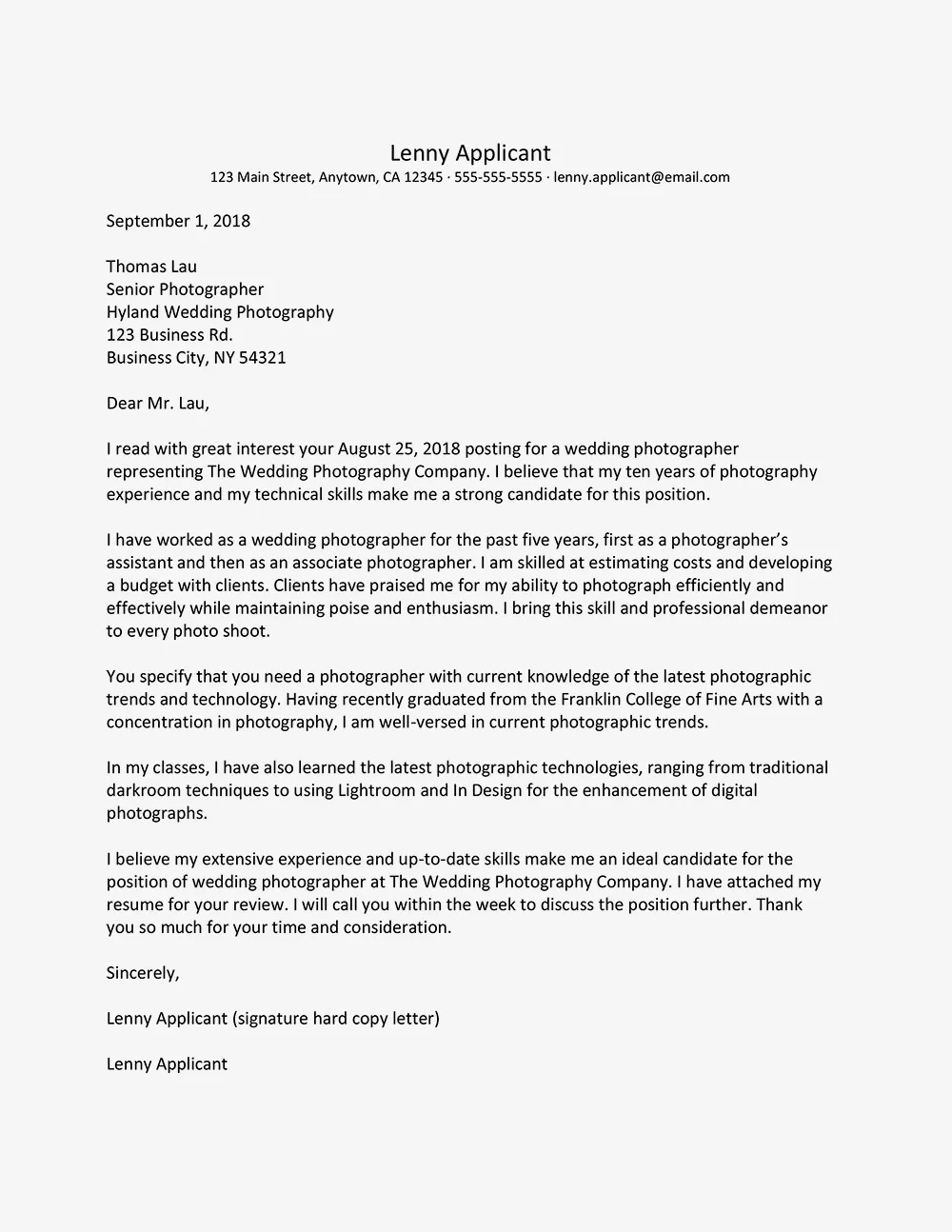
Carefully proofread and edit your cover letter to eliminate any errors in grammar, spelling, and punctuation. Ensure that the formatting is consistent and professional. Ask a friend, mentor, or career counselor to review your letter for clarity and accuracy. A polished and error-free cover letter demonstrates professionalism and attention to detail, which are essential qualities for a photographer. Make sure the tone is appropriate for the opportunity and is a reflection of your personality and communication skills.
Common Mistakes to Avoid in a Photographer Cover Letter
Using Generic Language
Avoid using generic phrases and clichés that don’t provide any specific details about your skills or experience. Instead of writing, ‘I am a creative and passionate photographer,’ provide concrete examples that demonstrate your creativity and passion. Use specific language that highlights your unique strengths and talents, differentiating you from other applicants. Generic language makes your application seem impersonal and less engaging. When demonstrating your unique strengths and talents, tailor the language to fit the job description and company’s specific needs.
Focusing Solely on Yourself
While it’s important to highlight your skills and experience, don’t make your cover letter all about you. Instead, focus on how your skills and experience align with the employer’s needs and how you can contribute to their goals. Show that you understand the company’s mission and values, and demonstrate your enthusiasm for the opportunity. A well-balanced cover letter will show your ability to fit well into the company’s culture. Show the value you bring, how you can address the company’s challenges, and what makes you the best fit for the position.
Failing to Proofread
Errors in grammar, spelling, and punctuation can damage your credibility and undermine your professionalism. Always proofread your cover letter carefully before sending it. Use a spell checker, but don’t rely on it entirely. Have someone else review your letter for you. A well-proofread cover letter demonstrates your attention to detail and commitment to quality. Always double-check all information and ensure that the overall message is clear and concise.
Maximizing Your Cover Letter’s Impact
A well-crafted cover letter can significantly increase your chances of landing a photography job or project. By understanding the key elements of an effective cover letter, tailoring it to each application, and avoiding common mistakes, you can create a compelling document that showcases your skills, experience, and passion for photography. Your cover letter is your chance to connect with potential employers and clients on a personal level, demonstrating your unique value and setting yourself apart from the competition. By following these guidelines, you can write a cover letter that opens doors and helps you succeed in your photography career.
